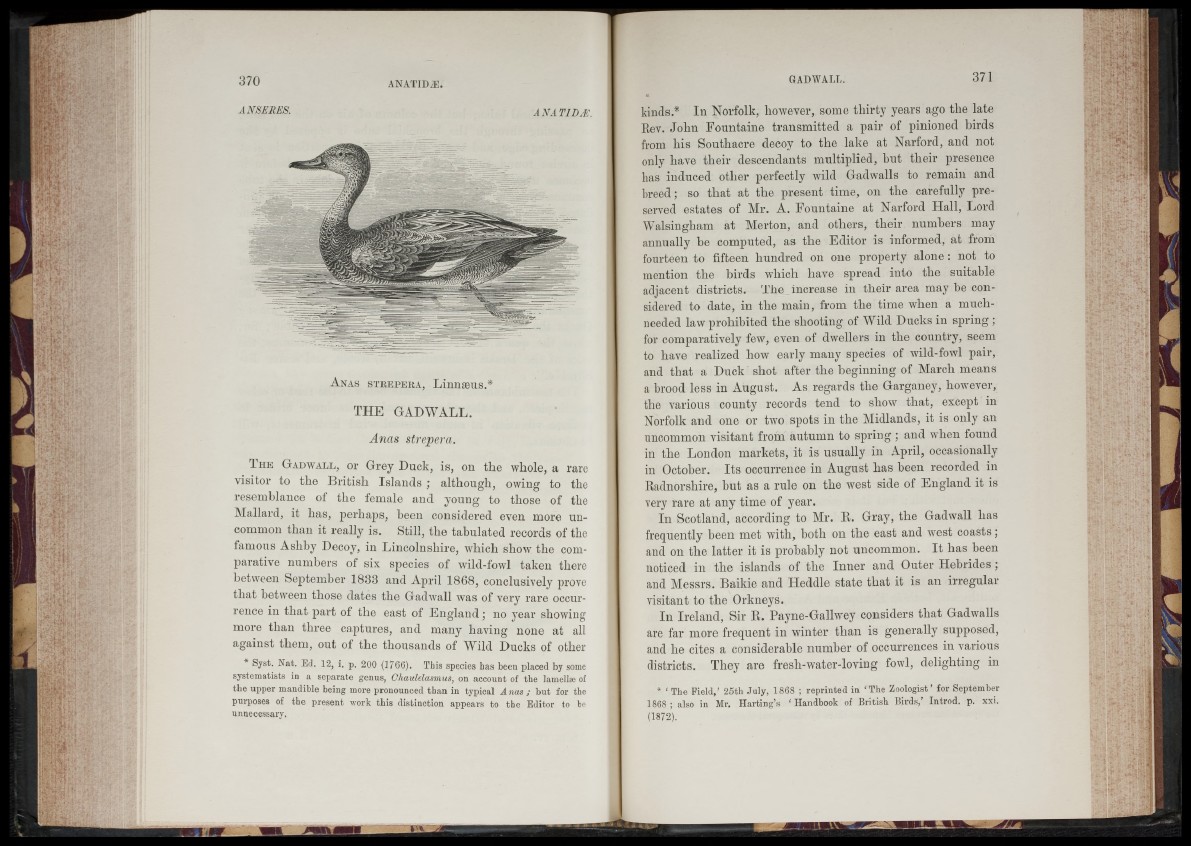
370 ANATIDiE
ANSERES. AN AT IBM.
A nas s t r e p e r a , Linnaeus.*
THE GAD WALL.
Anas strepera.
I h e G a dw a l l , or Grey Duck, is, on the whole, a rare
visitor to the British Islands ; although, owing to the
resemblance of the female and young to those of the
Mallard, it has, perhaps, been considered even more uncommon
than it really is. Still, the tabulated records of the
famous Aslihy Decoy, in Lincolnshire, which show the comparative
numbers of six species of wild-fowl taken there
between September 1833 and April 1868, conclusively prove
that between those dates the Gadwall was of very rare occurrence
in that part of the east of England; no year showing
more than three captures, and many having none at all
against them, out of the thousands of Wild Ducks of other
Syst. Nat. Ed. 12, i. p. 200 (1766). This species has been placed by some
systematists in a separate genus, Ckaulelasmus, on account of the lamellae of
the upper mandible being more pronounced than in typical Anas ; but for the
purposes of the present work this distinction appears to the Editor to be
unnecessary.
GADWALL. 371
kinds.* In Norfolk, however, some thirty years ago the late
Rev. John Fountaine transmitted a pair of pinioned birds
from his Southacre decoy to the lake at Narford, and not
only have their descendants multiplied, but their presence
has induced other perfectly wild Gadwalls to remain and
breed; so that at the present time, on the carefully preserved
estates of Mr. A. Fountaine at Narford Hall, Lord
Walsingham at Merton, and others, their numbers may
annually be computed, as the Editor is informed, at from
fourteen to fifteen hundred on one property alone : not to
mention the birds which have spread into the suitable
adjacent districts. The increase in their area may be considered
to date, in the main, from the time when a much-
needed law prohibited the shooting of Wild Ducks in spring ;
for comparatively few, even of dwellers in the country, seem
to have realized how early many species of wild-fowl pair,
and that a Duck shot after the beginning of March means
a brood less in August. As regards the Garganey, however,
the various county records tend to show that, except in
Norfolk and one or two spots in the Midlands, it is only an
uncommon visitant from autumn to spring ; and when found
in the London markets, it is usually in April, occasionally
in October. Its occurrence in August has been recorded in
Radnorshire, but as a rule on the west side of England it is
very rare at any time of year.
In Scotland, according to Mr. It. Gray, the Gadwall has
frequently been met with, both on the east and west coasts;
and on the latter it is probably not uncommon. It has been
noticed in the islands of the Inner and Outer Hebrides ;
and Messrs. Baikie and Heddle state that it is an irregular
visitant to the Orkneys.
In Ireland, Sir R. Payne-Gallwey considers that Gadwalls
are far more frequent in winter than is generally supposed,
and he cites a considerable number of occurrences in various
districts. They are fresh-water-loving fowl, delighting in